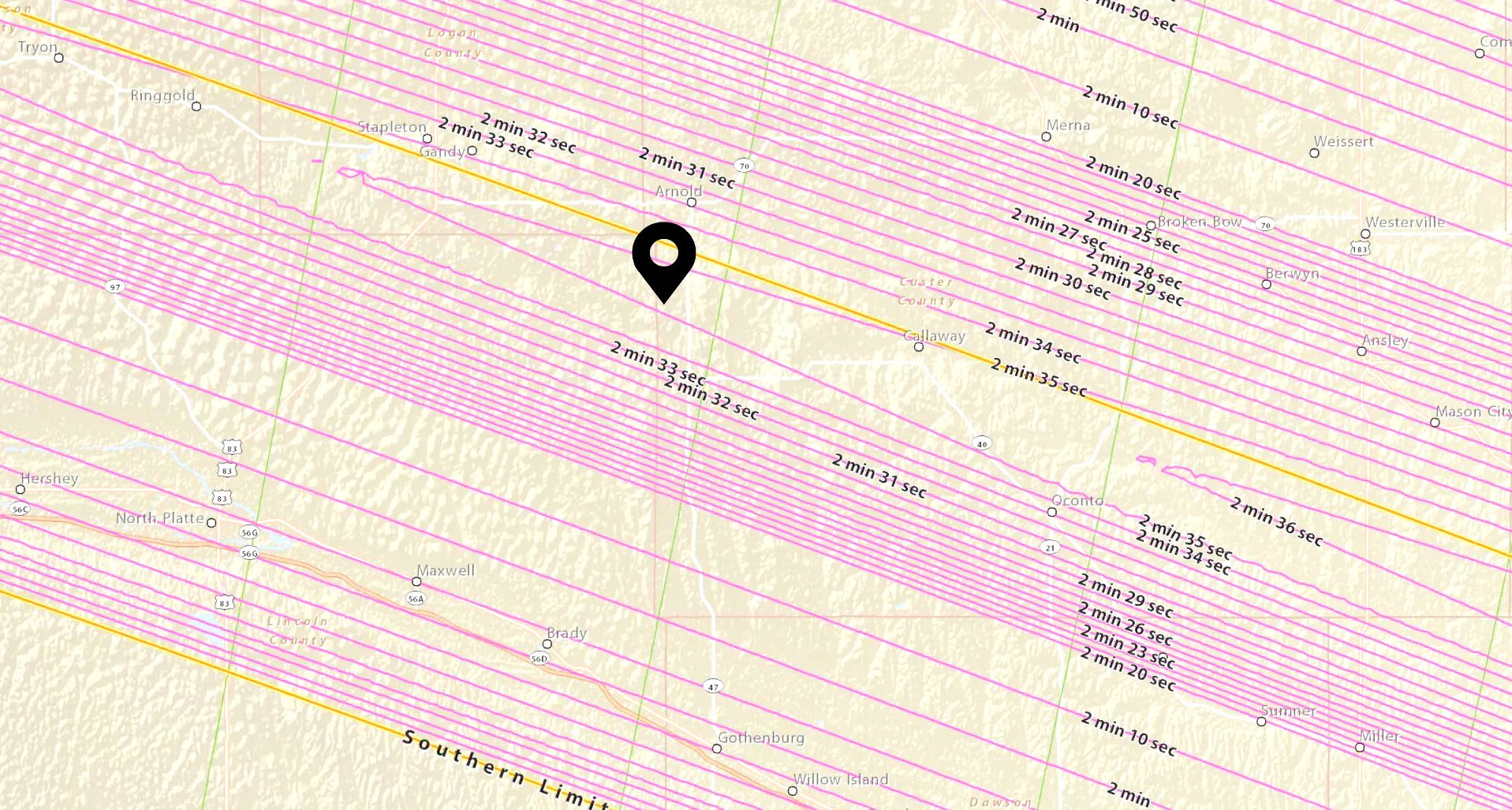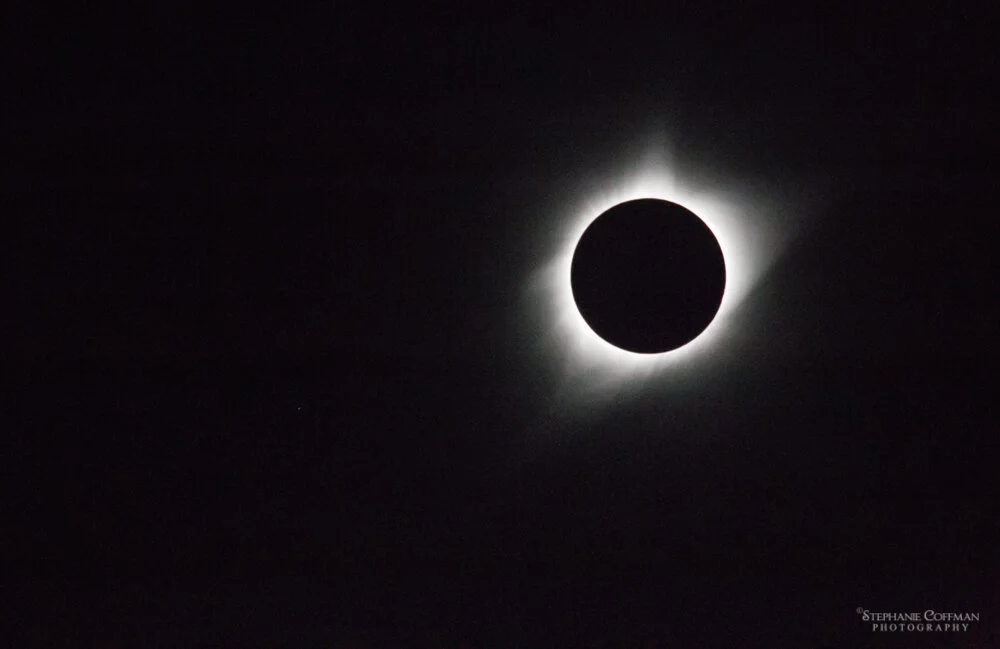Total Solar Eclipse 2017
What is a total solar eclipse?
A total solar eclipse occurs during a New Moon when the moon passes between the sun and the earth, casting its umbral shadow (the darkest part of its shadow) on the earth. The path that the umbral shadow casts across the earth is the path of totality.
The whole event lasts around 3 hours. Most of that time is spent in the penumbral shadow of the moon where the moon partially blocks the sun. Totality (being in the umbral shadow) typically lasts just a few minutes.
On August 21, 2017 a total solar eclipse was visible from across much of the United States. This was our first time experiencing a total solar eclipse and we are committed to making sure it won’t be our last!
The path of totality across the U.S. (Eclipse Predictions by Fred Espenak, NASA GSFC Emeritus)
We, along with my husband’s parents, left our home near Des Moines, Iowa bright and early to drive west the morning of August 21st. We didn’t know how far we were going, but we wanted to go far enough to escape the cloud cover and be in the path of totality. After several hours of driving, we turned north off of I-80 at Gothenburg, Nebraska and found a spot on the side of a dirt road to set up.
Our location (41.328633, -100.209293) right in the center of the path of totality where we expected to get over 2.5 minutes of darkness.
We weren’t the only ones that decided to set up along this road. It was really cool to see other people show up at this dirt road in the middle of Nebraska for the sole purpose of experiencing a total solar eclipse.
So, what are the stages of a total solar eclipse?
First contact - the moon begins to cover the sun, almost looking like it’s taking a “bite” out of the sun
Second contact - this happens a few minutes before totality and observers in the path of totality may be able to see the “diamond ring” effect
Totality - the moon completely covers the sun, the skies are dark and only the sun’s corona is visible
Third contact - the moon starts uncovering the sun and the “diamond ring” effect becomes visible again
Fourth contact - the moon is no longer covering the sun
We used the app Solar Eclipse Timer which notified us based on our location what stage we were in and how much time was left until the next stage started.
Safety first! Here we are wearing our fashionable safety eyewear during first contact as we watch the moon slowly cover the sun.
During first contact, the penumbral shadow created what I can only describe as strange lighting on the surrounding landscape. Colors were a little more muted and the tones different. You can sort of see this in the photo above. The surrounding landscape was much brighter and vibrant prior to first contact.
The moon taking a bite out of the sun during first contact
Canon EOS 6D - 600mm, f/11, ISO-250, 1/60 sec
In the minutes leading up to totality, the skies began to darken more quickly. It was bizarre to see darkness arriving from the west rather than from the east. Jess was taking a timelapse that required manual adjustments from the quickly changing light. Meanwhile, I was taking test shots to check my camera settings in anticipation of the short window I would have to capture the moon fully covering the sun.
And then it happened. We were able to take our solar filter glasses off and look at the darkness of the moon now surrounded by the sun’s corona. Wow! I scrambled to get my camera settings just right and took several photos knowing we didn’t have long, but also paused a few times to try to take it all in. Looking around, it was like a 360 degree sunset and up in the sky was this beautiful, wispy ring, a part of the sun that we rarely get to see with the naked eye. To say it was an incredible experience is an understatement.
My camera setup during totality. Jess is set up with his timelapse in the lower right.
A single frame from the timelapse that Jessie shot
For my first time experiencing and photographing a total solar eclipse, I was really happy with what I came back with. That 2.5 minutes went so fast though! Below are my 3 favorite shots.
↓↓↓
Totality
Canon EOS 6D - 520mm, f/13, ISO-25600, 1/4000 sec
Just starting 3rd contact
Canon EOS 6D - 520mm, f/13, ISO-25600, 1/4000 sec
The “diamond ring” effect at the start of 3rd contact
Canon EOS 6D - 520mm, f/13, ISO-25600, 1/4000 sec
Jess’ timelapse of the total solar eclipse!
Behind the scenes
Perhaps you are thinking to yourself, “I want to see a total solar eclipse!” Well friends, below are the upcoming total solar eclipses through 2030. We’ll be making plans to go somewhere for the 2024 eclipse as it passes through several U.S. states.
| Date | Path of Totality Visibility |
| 2021 Dec 04 | Antarctica |
| 2024 Apr 08 | Mexico, United States, Canada |
| 2026 Aug 12 | Greenland, Iceland, Spain |
| 2027 Aug 02 | Northern Africa, Middle East |
| 2028 Jul 22 | Australia, New Zealand |
| 2030 Nov 25 | South Africa, Australia |
More details via NASA (https://eclipse.gsfc.nasa.gov/SEgoogle/SEgoogle2021.html)










